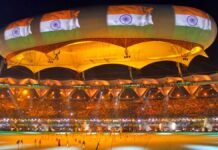
Ayodhya: The holy city of Ayodhya is all set to witness the historic consecration ceremony of the Ram temple on Monday, January 22, 2024, at 12:20 pm. Prime Minister and other dignitaries will attend the ceremony, which marks the culmination of a decades-long legal and political struggle. The event is expected to be watched by millions of people across the country and the world, who consider Lord Ram as their supreme deity and cultural icon.
Preparations
The preparations for the ceremony have been completed with utmost devotion and enthusiasm. On Sunday, the idol of Ramlala, the infant form of Lord Ram, was bathed with holy water brought from various pilgrimage sites, such as the Ganga, Yamuna, Narmada, Godavari, Kaveri, and Brahmaputra rivers. The idol was then placed in a temporary shrine called ‘Madhyadhivas’, where it will remain till the ceremony. A night-long vigil called ‘Ratri Jagran Adhivas’ will be held on Sunday night, where the old idol of Ram Lala, which was worshipped for years at the disputed site, will be offered prayers in a ‘Yagyashala’, a sacred fire altar. The rituals will be performed with flowers brought from many places, including Chennai and Pune.
Some of the people invited to the ceremony, including religious leaders, politicians, social workers, and celebrities, reached Ayodhya on Sunday, while others are expected to arrive on Monday morning. The invitees include Rashtriya Swayamsevak Sangh (RSS) chief Mohan Bhagwat, Uttar Pradesh Chief Minister Yogi Adityanath, former Deputy Prime Minister L.K. Advani, and yoga guru Baba Ramdev. The ceremony will be conducted by 21 priests from Varanasi, Ayodhya, and Prayagraj, who will recite Vedic hymns and perform rituals. The ceremony will also feature a ‘Bhoomi Pujan’, a worship of the land, and a ‘Shila Pujan’, a worship of the foundation stone.
Celebrations
The consecration ceremony of the Ram temple is not only a matter of joy and pride for the people of Ayodhya but also for the Hindus across the world. To celebrate the occasion, events have been announced for January 22 in different parts of the world, from Washington DC to Paris and Sydney. These events are being organized by the Vishwa Hindu Parishad (VHP) or the Hindu diaspora community in 60 countries. The events will include prayers, chants, cultural programs, and fireworks. In India, many state governments, including the Central Government, have announced a half-day holiday on Monday, to enable people to watch the ceremony live on television and online.
Ayodhya has been decorated with flowers and lights, and ‘Ram Dhun’, a musical rendition of Lord Ram’s name, was played on loudspeakers installed at various places on Sunday. The townspeople came out on the streets dressed as Lord Ram, Mother Sita, Lakshman, and Hanuman, the main characters of the epic Ramayana, which narrates the life and deeds of Lord Ram. They were followed by mesmerized devotees who also joined the rallies. Floral patterns and ceremonial gates depicting ‘Jai Shri Ram’, a slogan meaning ‘Hail Lord Ram’, with lights enhancing the aura of the city. The new 51-inch idol of Ramlala, made by Mysuru-based sculptor Arun Yogiraj, was installed in the sanctum sanctorum of the temple on Thursday afternoon. The idol is made of black stone and weighs 1.25 quintals. It depicts Ramlala sitting on a lotus, holding a bow and arrow in his hands.
Temple Design
The Ram temple, which is being built on the site where a 16th-century mosque was demolished by Hindu activists in 1992, is expected to be completed by 2025. The temple will be a grand structure, reflecting the ancient and traditional architecture of India. The temple will be three-storeyed, with a height of 161 feet, a length of 380 feet, and a width of 250 feet. Each floor of the temple will be 20 feet high and will have a total of 392 pillars and 44 gates. The temple will be built in the Nagar style, which is characterized by a square plan, a shikhara (spire), and a mandapa (hall). The temple will also have five domes, representing the five brothers of Lord Ram, and a gold-plated kalash (pot) on top of the main dome.
The temple will be accessible from the eastern direction, and the exit will be from the south direction. Devotees will have to climb 32 steps from the eastern side to reach the main temple, where they will be able to offer prayers to the idol of Ramlala. The temple complex will also have a museum, a library, a research center, a food court, and a parking lot. The temple will be surrounded by a wall, which will have carvings of scenes from the Ramayana and other Hindu scriptures. The temple will also have a ‘Ramkatha Kunj’, a park where devotees can listen to the stories of Lord Ram.
The temple is being constructed by the Ram Janmabhoomi Teerth Kshetra Trust, a body formed by the Supreme Court in 2019 after it gave its verdict in favor of the Hindus in the long-pending land dispute case. The trust has collected over Rs 2,500 crore from donations from people across the country and the world for the temple construction. The trust has also invited 14 couples from different parts of India to be the ‘hosts’ for the consecration ceremony. These couples belong to different castes, regions, and backgrounds, and symbolize the unity and diversity of the Hindu society.

Security and Health
The Uttar Pradesh government is leaving no stone unturned to prepare for this special day and ensure the safety and well-being of the people. Policemen have been deployed at every nook and corner of the city, and CCTV cameras have been installed strategically. Barriers with barbed wire have been erected at every main intersection of the temple town, and entry and exit points have been regulated. National Disaster Response Force (NDRF) teams trained to deal with incidents like earthquakes and floods as well as chemical, biological, radiological, and nuclear attacks have also been deployed. The administration has also made arrangements to deal with any health emergency given the cold outbreak, which has claimed over 100 lives in the state. Beds have been reserved in Ayodhya and district hospitals and the medical colleges here. Experts from the All India Institute of Medical Sciences (AIIMS) have trained doctors in healthcare institutions to deal with emergencies. The administration has also issued guidelines for the people attending the ceremony, such as wearing masks, maintaining social distance, and avoiding large gatherings. The administration has also appealed to the people to celebrate the occasion peacefully and harmoniously and respect the sentiments of all communities.




















































